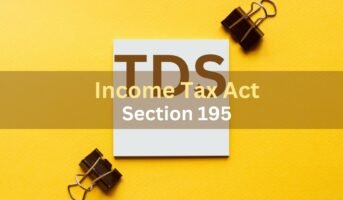Under the income tax laws in India, employers have been tasked with the job of deducting tax from the income of the employees at the time of payment of the salary. Section 192 of the Income Tax Act, 1961, establishes the ground rules on TDs deduction on salary.
See also: All about TDS on salary
What is Section 192?
Section 192 of the income tax law 1961 provides that every person responsible for paying any income which is chargeable under the head ‘salary’ should deduct income tax on the estimated income of the assessee under the head salaries.
know about: 80e deduction limit
Who deducts TDS on salary under Section 197?
The legal framework requires the employer to deduct tax at the appropriate rates from salary payments made to employees.
For the various categories of employers, the persons responsible for making payment under the head salaries and for deduction of tax are as below:
Central/state government/PSU: Drawing & disbursing officer
Private & public companies: Company
Firm: Managing partners/partner
Proprietorship concern: Proprietor
Trusts: Managing trustee
see also about: 80ccd of income tax act
The employee from whose salary tax has been deducted at source gets the credit of the amount deducted in his personal assessment on the basis of the certificate issued by the employer. This certificate is given in Form 16 is given to employees by their employers, and it is on this form that the TDS is deducted under Section 192.
see also: Section 115JD Income Tax Act: Credits and claiming process
Who receives the TDS deducted from salary under Section 197?
The deducted sum is required to be deposited to the credit of the Central government.
Read about: income tax refund pending
TDS rate on salary
TDS is required to be calculated at the average rate of income tax. The employer has to calculate the income tax depending on the tax regime an employee has chosen. Taxpayers in India currently have the option to opt for either the old tax regime or the new tax regime. Tax rates under these regimes are different.
Tax slab under new tax regime
| Income | New tax regime slab |
| Up to Rs 3 lakh | Nil |
| From Rs 3 lakh to Rs 6 lakh | 5% |
| From Rs 6 lakhs to Rs 9 lakh | 10% |
| From Rs 9 lakh to Rs 12 lakh | 15% |
| From Rs 12 lakhs to Rs 15 lakh | 20% |
| Above Rs 15 lakh | 30% |
| Source: Budget 2023-24 |
Income tax slabs for individual aged below 60 years & HUF (old tax regime)
| Income | Old tax regime slab |
| Up to Rs 2.50 lakh | Nil |
| From Rs 2.50 lakh-Rs 5 lakh | 5% |
| From Rs 5 lakh-Rs 7.50 lakh | 20% |
| From Rs 7.5 lakh-Rs 10 lakh | 20% |
| From Rs 10 lakh-Rs 12.50 lakh | 30% |
| From Rs 12.50 lakh-Rs 15 lakh | 30% |
| Above Rs 15 lakh | 30% |
Income tax slabs for individual aged between 60-80 years
| Income | Old tax regime slab |
| Up to Rs 3 lakh | Nil |
| From Rs 3 lakh-Rs 5 lakh | 5% |
| From Rs 5 lakh-Rs 10 lakh | 20% |
| Over Rs 10 lakh | 30% |
Income tax slabs for individual aged over 80 years
| Income | Old tax regime slab |
| Up to Rs 5 lakh | Nil |
| From Rs 5 lakh-Rs 10 lakh | 20% |
| Above Rs 10 lakh | 30% |
Deductions in old tax regime
Taxpayers are given the option to claim several deductions for money they spend for specific investment purposes under the old tax regime. The employer has to deduct these eligible expenses to calculate the total tax liability.
List of tax saving instruments
Life insurance
Health insurance
ULIPs
Equity-linked Tax Saving Scheme (ELSS)
Public Provident Fund or PPF
National Saving Certificates or NSC
Infrastructure Bonds
Fixed Deposit
List of main sections offering income tax deduction
Section 80RRB
Section 80U
Calculating tax deduction under Section 192
Assuming that your yearly income is Rs 15 lakh, here is how the TDS on your salary will be calculated under the old and new tax regime, without factoring in any exemptions allowed under the old tax regime:
| Particulars | Old regime | New regime |
| Total income | Rs 15 lakh | Rs 15 lakh |
| Standard deduction | Rs 50,000 | Rs 50,000 |
| Taxable income | Rs 14,50,500 | Rs 14,50,500 |
| Tax due | Rs 2,57,400 | Rs 1,45,600 |
| TDS per month | Rs 21,450 | Rs 12,133 |
TDS payment due date
The deadlines for paying the tax deducted at source and submitting the TDS return for the financial year 2022-23 are shown in the table below.
| Quarter | Quarter Period | TDS Return Due Date |
| 1st Quarter | April 1 to June 30 | July 31 2022 |
| 2nd Quarter | July 1 to September 30 | October 31 2022 |
| 3rd Quarter | October 1 to December 31 | January 31 2023 |
| 4th Quarter | January 1 to March 31 | May 31 2023 |
TDS deduction at a lower rate or non-deduction of tax
Section 197 enables a taxpayer to make an application to his assessing officer for deduction of tax at a lower rate or non deduction of tax. The application has to be made in Form No.13 (Rule 28AA). If the assessing officer is satisfied that the total income of a tax payer justifies the deduction of income tax at any lower rate or no deduction of income tax, he may issue a certificate in Form No. 15AA (relevant Rule 28AA).
Know about: Section 80ee
Refund of TDS
In case of excess deduction of tax at source, the excess amount is refundable. The difference between the actual payment made by the deductor and the tax deductible at source, will be treated as the excess payment made.
TDS statements in Form 16
Your employer is obligated to provide you with a copy of Form 16 that contains the specifics of your salary, such as the amount paid and the amount of tax that was withheld. In addition to this, you may also attach a Form 12BA to provide specifics on perks and profits in place of income. Part A of Form 16 shows tax deposited by book entry while part B of Form 16 shows tax deposited through challan.
FAQs
What is Form 16?
Employers of those who earn a taxable income are liable to deduct tax, known as TDS, while paying salaries. This tax deduction on the part of the employer, is documented in Form 16.
What is Form 16 issue date?
Form 16 is issued by your employer every year on or before June 15. Form 16 is issued right after the financial year, in which the tax is deducted.
Why did my employer not issue Form 16?
Your employer may not issue Form 16 if your salary is below the basic exemption limit.
Will TDS be deducted from my salary even if my salary is below basic exemption limit?
No, TDS is required to be deducted at source unless the estimated salary income exceeds the maximum amount not chargeable to tax applicable in case of an individual during the relevant financial year.

An alumna of the Indian Institute of Mass Communication, Dhenkanal, Sunita Mishra brings over 16 years of expertise to the fields of legal matters, financial insights, and property market trends. Recognised for her ability to elucidate complex topics, her articles serve as a go-to resource for home buyers navigating intricate subjects. Through her extensive career, she has been associated with esteemed organisations like the Financial Express, Hindustan Times, Network18, All India Radio, and Business Standard.
In addition to her professional accomplishments, Sunita holds an MA degree in Sanskrit, with a specialisation in Indian Philosophy, from Delhi University. Outside of her work schedule, she likes to unwind by practising Yoga, and pursues her passion for travel.
[email protected]











